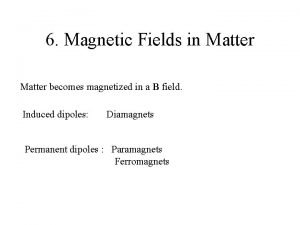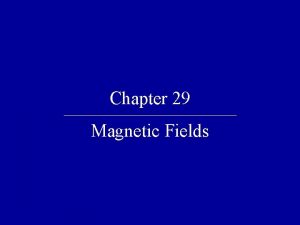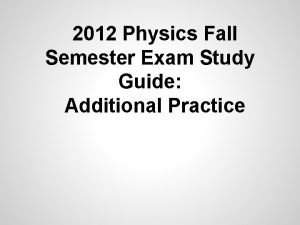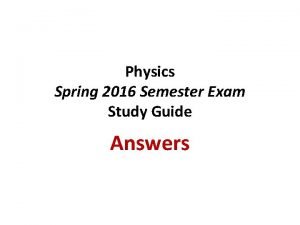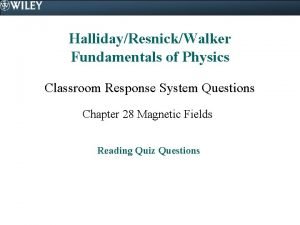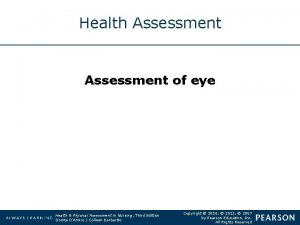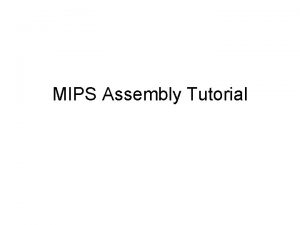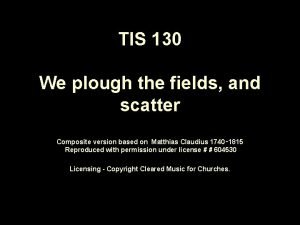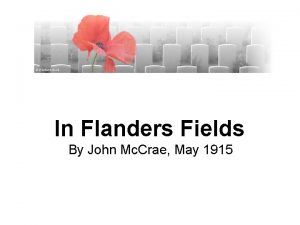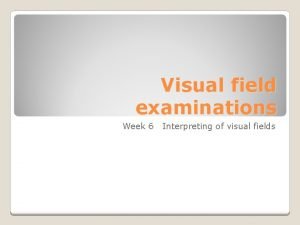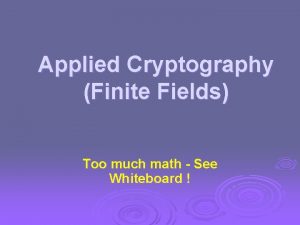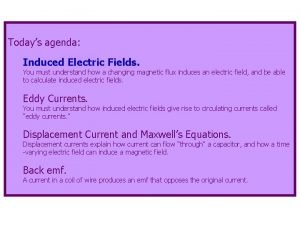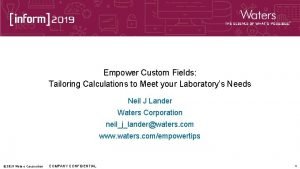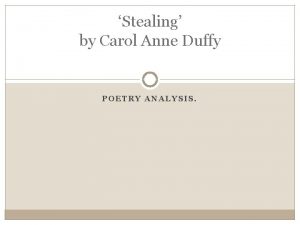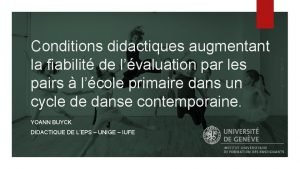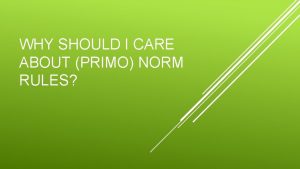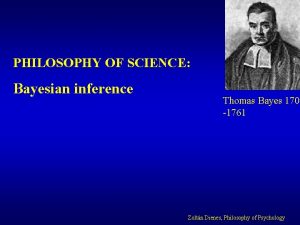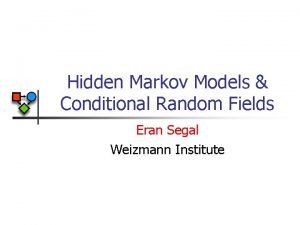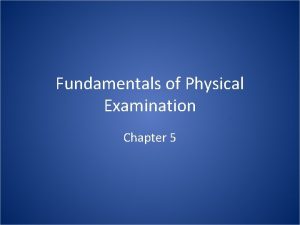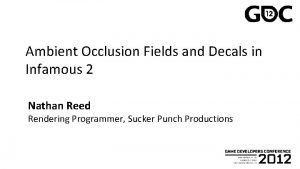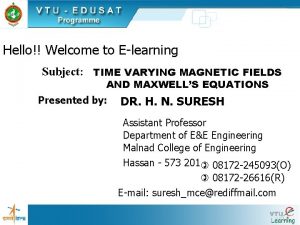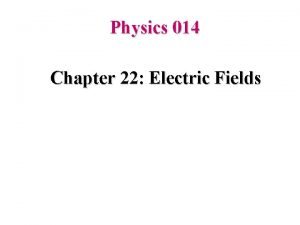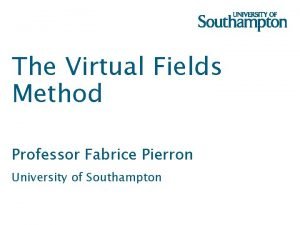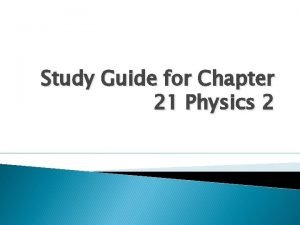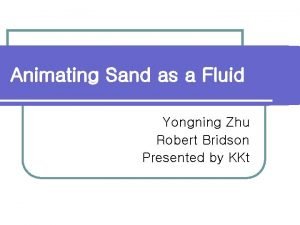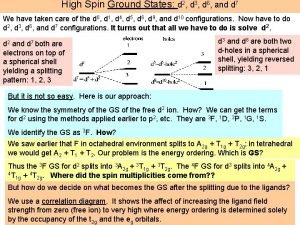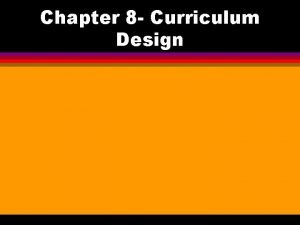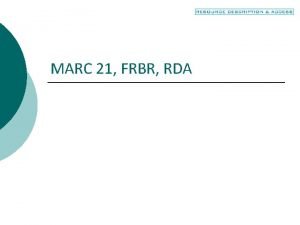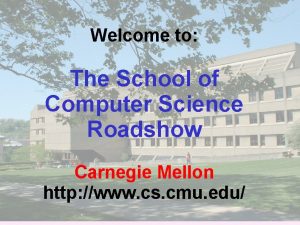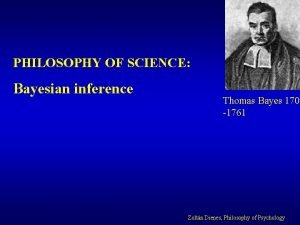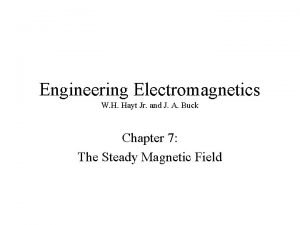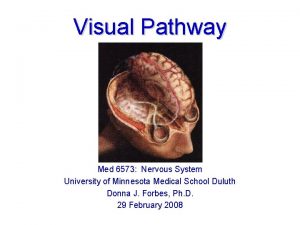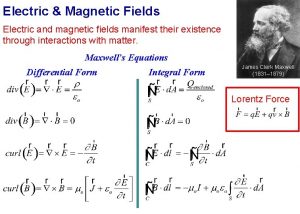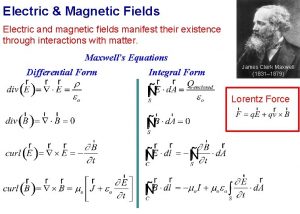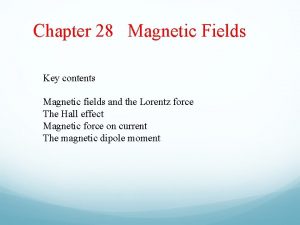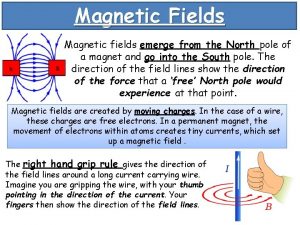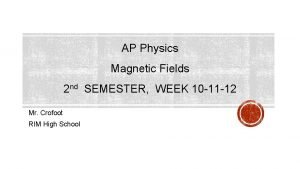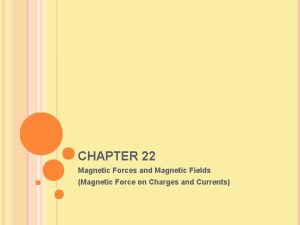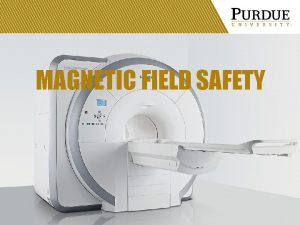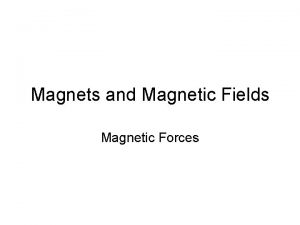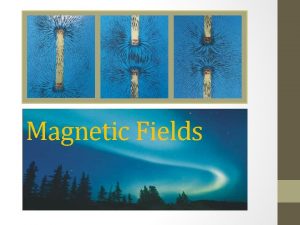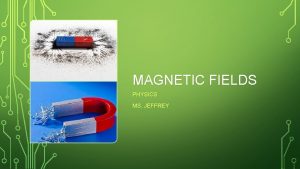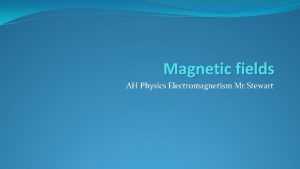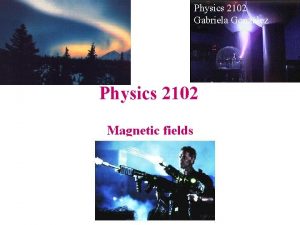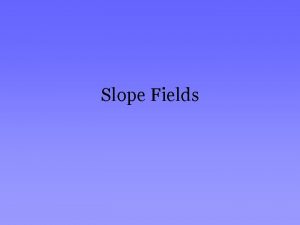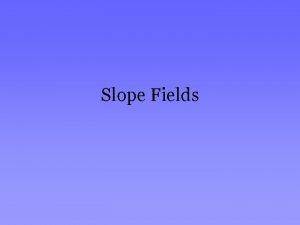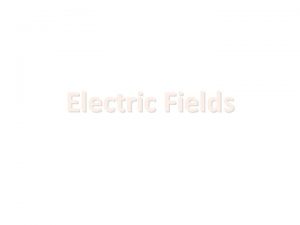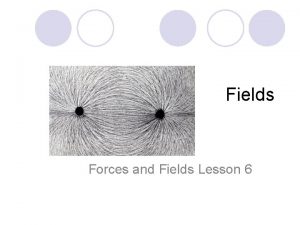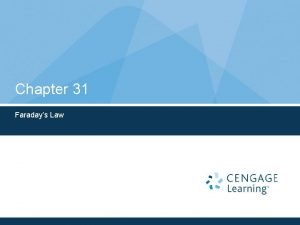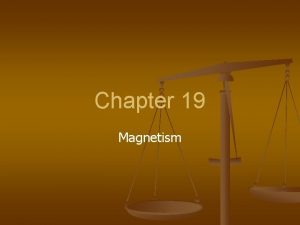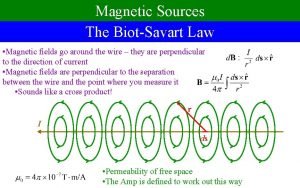AP Physics Magnetic Fields 2 nd SEMESTER WEEK


































































- Slides: 66

AP Physics Magnetic Fields 2 nd SEMESTER, WEEK 10 -11 -12 Mr. Crofoot RIM High School

Induction and Inductance 4/17/17 Interactive Notebook, Write on page 52 Induced Electric Fields • A ring conductor develops a current in a changing magnetic field. • Therefore, an electric field must be present to do the work of moving the electrons. • Even if the conducting ring were not present, the changing magnetic field produces an electric field.

Induction and Inductance 4/17/17 Interactive Notebook, Write on page 52

Induction and Inductance 4/17/17 Interactive Notebook, Write on page 52

Induction and Inductance 4/17/17 Interactive Notebook, Practice on page 53 Do: Page 804 Checkpoint 4 Page 820 Problem 27 Page 820 Problem 29

Induction and Inductance 4/18/17 Starter Plicker Electric Field lines from static charges start on positive charges and end on negative charges. Electric Field lines induced from a changing magnetic field – a) Spiral forward in the direction of the increasing magnetic field b) Spiral forward in the direction of the decreasing magnetic field c) Make a closed loop in the direction opposite the right hand rule (opposite thumb pointing in direction of increasing magnetic field – fingers pointing in the direction of the electric field) d) Make a closed loop in the direction of the right hand rule (thumb pointing in direction of increasing magnetic field – fingers pointing in the direction of the electric field)

Induction and Inductance 4/18/17 Interactive Notebook, Write on page 54

Induction and Inductance 4/18/17 Interactive Notebook, Write on page 54

Induction and Inductance 4/18/17 Interactive Notebook, Write on page 55

Induction and Inductance 4/18/17 Interactive Notebook, Write on page 55 CORRECTION

Induction and Inductance 4/18/17 Interactive Notebook, Practice on page 56 Do: Page 810 Checkpoint 6 Page 820 Question 51 LR Demonstration


Induction and Inductance 4/20/17 Interactive Notebook, Write on page 57

Induction and Inductance 4/20/17 Interactive Notebook, Write on page 57

Induction and Inductance 4/20/17 Interactive Notebook, Write on page 57

Induction and Inductance 4/20/17 Interactive Notebook, Write on page 58

Induction and Inductance 4/20/17 Interactive Notebook, Write on page 58

Induction and Inductance 4/20/17 Interactive Notebook, Write on page 59 Mutual Induction • Mutual induction is the Emf induced in coil 2 by the changing magnetic flux established by the changing current in coil 1. • Recall the Self Induction is the opposing Emf in coil 1 by changing current in coil 1.

Induction and Inductance 4/20/17 Discovery Lab Record on a separate sheet of paper one per group Inductors and Transformers • Obtain two AC transforms. • Plug the lowest voltage transformer in and use it as a source of AC power. • Use the second transformer in the circuit shown in series with a 150 ohm resistor. • Make the following measurements. 1. Resistance of 150 ohm Resistor: 2. Resistance of primary coil of 2 nd transformer: 3. Resistance of these in series: With the 1 st transformer supplying voltage across the resistor and primary coil of 2 nd transformer. Be sure secondary of 2 nd transformer are not shorted. 1. Voltage across the Resistor 2. Voltage across the primary coil of 2 nd transformer: 3. Voltage of these in series 4. Voltage of the secondary coil of 2 nd transformer. 5. Repeat 1 -6 with the wires of the secondary coil of 2 nd transformer shorted.


Induction and Inductance 4/20/17 Interactive Notebook, Practice on page 60 Do: Page 822 Question 63, 65, 68, 69

= 5. 00Ω = 12. 0 V = 500 m. H

Electromagnetic Oscillations 4/24/17 Interactive Notebook, Write on page 61

Electromagnetic Oscillations 4/24/17 Interactive Notebook, Write on page 61 LC Circuit • The energy oscillation in an LC circuit would go on infinitely if there were no resistance. • The magnitude of the current or voltage with respect to time behaves sinusoidal. • An analogy to an oscillating block and spring can be made. x→ q v→ i K → 1/C m→ L Block-Spring LC Oscillator Capacitor Block Inductor

Electromagnetic Oscillations 4/24/17 Interactive Notebook, Write on page 61 LC Circuit x→ q v→ i K → 1/C m→ L Block-Spring LC Oscillator Capacitor Block Inductor

Electromagnetic Oscillations 4/24/17 Interactive Notebook, Practice on page 62 Do: Page 829 Check Point 1 Page 853 -854 Question 3 Page 855 Problem 5

500 m. H = = 500 m. F

Electromagnetic Oscillations 4/25/17 Interactive Notebook, Write on page 63 LC Circuit • Continuing our analogy to Newtonian Block and Spring, the time oscillations of charge and current are described by: q = Q cos(ωt + Ф) i = dq/dt = - ωQ sin(ωt + Ф) • ωQ is the maximum amplitude of the current, I. i=- I sin(ωt + Ф) • By convention, q and i are instantaneous charge and current; Q and I are maximum charge and current.

Electromagnetic Oscillations 4/25/17 Interactive Notebook, Write on page 63

Electromagnetic Oscillations 4/25/17 Interactive Notebook, Write on page 63

Electromagnetic Oscillations 4/25/17 Interactive Notebook, Write on page 63

Electromagnetic Oscillations 4/25/17 Interactive Notebook, Write on page 63

Electromagnetic Oscillations 4/25/17 Demonstration of damped oscillation of RLC circuit

Electromagnetic Oscillations 4/25/17 Interactive Notebook, Write on page 64

Electromagnetic Oscillations 4/25/17 Interactive Notebook, Write on page 64 • When the two angular frequencies match, the circuit is said to be in resonance.

Electromagnetic Oscillations 4/25/17 Interactive Notebook, Practice on page 65 Do: Page 833 Check Point 2 Page 853 -854 Question 5 Page 855 Problem 25

Electromagnetic Oscillations 4/27/17 Starter Plicker The damped charge with respect to time on a capacitor in an RLC circuit is described by the equation: q = Q e-Rt/2 L cos(ω’t + Ф) What part of the equation determines the damping and prevents the oscillations from going on forever? a) cos(ω’t + Ф) b) Ф c) Q d) e-Rt/2 L

Electromagnetic Oscillations 4/27/17 Interactive Notebook, Write on page 66

Electromagnetic Oscillations 4/27/17 Interactive Notebook, Write on page 66

Electromagnetic Oscillations 4/27/17 Interactive Notebook, Write on page 66

Electromagnetic Oscillations 4/28/17 Interactive Notebook, Write on page 68 • The phasors for the three simple AC driven circuits are as shown below.

Electromagnetic Oscillations 4/27/17 Interactive Notebook, Practice on page 67 Do: Page 838 -842 Check Point 3, 5, 6 Page 855 Problem 29

Electromagnetic Oscillations 4/28/17 Starter Plicker If the red phasor represents the current in each component, which set of phasors describe V(resistor), V(capacitor), V(inductor) in AC driven circuits? A. Green, Purple, Blue B. Green, Blue, Purple C. Purple, Green, Blue D. Purple, Blue, Green 15 10 Axis Title 5 -10 -5 0 V(A) 0 -5 -10 -15 Current Axis Title 5 10 15 V(B) V(C)

Electromagnetic Oscillations 4/28/17 Interactive Notebook, Write on page 68 • The phasors for the three simple AC driven circuits are as shown below. • Today, we will extend that analysis to more complicated circuits.

Electromagnetic Oscillations 4/28/17 Interactive Notebook, Write on page 68 • Now we will apply the alternating Emf to a full RLC circuit. Emf = Emf(max) sin ωdt • The current is the same throughout the circuit: i = I sin (ωdt-Ф) • The phasor representation of current and the Emf at each component is displayed. • The x-axis represents the cyclic time. • The length of each arrow represents the maximum for that variable. • The projection of the arrow on the y-axis represents the instantaneous value of the variable.

Electromagnetic Oscillations 4/28/17 Interactive Notebook, Write on page 68 • Since the RLC circuit is driven by the AC Emf, it is not damped and takes on the frequency, ωd. • Emf(max) is the phasor labelled Vm, and it’s length is the amplitude of the driving Emf. It’s projection on the y-axis is the value of the driving Emf at any time t. • Since Emf=VR + VC + VL, the Vm phasor is the vector sum of the other three. • Since VL and VC are opposite direction we call their difference VL-VC a single phasor that we will add to the VR phasor vector to get Vm. • Applying Pythagorean Theorem: Emf(max)2 = VR 2 +(VL-VC)2 Vm=IZ




Electromagnetic Oscillations 4/28/17 Interactive Notebook, Write on page 69

Electromagnetic Oscillations 4/28/17 Interactive Notebook, Practice on page 70 Do: Page 854 Question 10 Page 857 Problem 41, 51, 61

Electromagnetic Oscillations 5/1/17 Starter Plicker Your house transformer converts 110 kv to 110 v. If the power line can deliver 0. 05 amps to the transformer, what is the maximum current available in your house? A. 5 x 10 -5 amps B. 50 amps C. 500 amps D. 5000 amps

Because magnetic field lines must start and end at a point, the net magnetic flux must always be zero.

B B • Because of the negative sign, Faraday’s Law (Lenz’s Law) Opposes.

Electromagnetic Oscillations 5/1/17 Interactive Notebook, Practice on page 72 Do: Page 863 and 866 CP 1 and 2 Page 882 Question 1 Page 883 Problem 1




Electromagnetic Oscillations 5/2/17 Interactive Notebook, Write on page 74 Maxwell’s Laws Name Equation Meaning Gauss’ Law for Electricity Relates the net electric field to the net enclosed electric charge Gauss’ Law for Magnetism Relates the net magnetic flux to the net enclosed magnetic charge Faraday’s Law Relates the induced electric field to the changing magnetic flux Ampere’-Maxwell Law Relates the induced magnetic field to the changing electric flux and the current

Electromagnetic Oscillations 5/2/17 Interactive Notebook, Practice on page 75 Do: Page 884 Problem 5, 12

Electromagnetic Oscillations 5/3/17 Starter Plicker Which of Maxwell’s equations can be used to determine the electric field in a capacitor? A. Guass’ Law for Electricity B. Guass’ Law for Magnetism C. Faraday’s Law D. Ampere-Maxwell Law

Electromagnetic Oscillations 5/4/17 Starter Plicker Yesterday, Troy reminded us Gauss’ Law uses an area vector. What direction does that area vector point? A. Parallel to the area surface using a right hand rule B. Perpendicular to the area surface out of the closed surface C. Parallel to the area surface using a left hand rule D. Perpendicular to the area surface into of the closed surface



Electromagnetic 5/8/17 Maxwell’s Laws Name Equation Meaning Gauss’ Law for Electricity Relates the net electric field to the net enclosed electric charge Gauss’ Law for Magnetism Relates the net magnetic flux to the net enclosed magnetic charge Faraday’s Law Relates the induced electric field to the changing magnetic flux Ampere’-Maxwell Law Relates the induced magnetic field to the changing electric flux and the current

 Red fields to green fields
Red fields to green fields Magnetic fields in matter
Magnetic fields in matter Lesson quiz 29-1
Lesson quiz 29-1 Learning: module 26: magnetic forces and fields
Learning: module 26: magnetic forces and fields Electric currents and magnetic fields
Electric currents and magnetic fields Magnets and magnetic fields lesson 1 answer key
Magnets and magnetic fields lesson 1 answer key Electric currents and magnetic fields
Electric currents and magnetic fields Magnetic force particle
Magnetic force particle Coercivity
Coercivity Flux in weber
Flux in weber Magnetic moment and magnetic field relation
Magnetic moment and magnetic field relation Week by week plans for documenting children's development
Week by week plans for documenting children's development Physics fall semester review answers
Physics fall semester review answers Honors physics semester 1 review
Honors physics semester 1 review Physics semester 1 final exam study guide answers
Physics semester 1 final exam study guide answers Physics classroom magnetic field
Physics classroom magnetic field Why does it happen
Why does it happen University physics with modern physics fifteenth edition
University physics with modern physics fifteenth edition Good physics ia topics
Good physics ia topics Six cardinal fields of gaze
Six cardinal fields of gaze John mccrae in flanders fields
John mccrae in flanders fields Mips tutorial
Mips tutorial Natural grass athletic fields
Natural grass athletic fields Kimberly fields usf
Kimberly fields usf We plough the fields and scatter modern version
We plough the fields and scatter modern version In flanders fields summary
In flanders fields summary Hemianopia
Hemianopia Sketching slope fields
Sketching slope fields Cambodia killing fields
Cambodia killing fields Finite fields in cryptography
Finite fields in cryptography Induced electric field in solenoid
Induced electric field in solenoid Potential fields
Potential fields Empower custom field calculation
Empower custom field calculation Electric fields
Electric fields Analysis of stealing by carol ann duffy
Analysis of stealing by carol ann duffy Natural language processing fields
Natural language processing fields Forever fields of greens benefits
Forever fields of greens benefits Norm rule fields
Norm rule fields 2829 elysian fields avenue
2829 elysian fields avenue Thomas morphic fields
Thomas morphic fields Eran fields
Eran fields Fill xxxx
Fill xxxx Semantic field
Semantic field Chapter 16: electric forces and fields answers
Chapter 16: electric forces and fields answers Egophony
Egophony Fields virology
Fields virology Empower custom fields validation
Empower custom fields validation Ao fields
Ao fields Regio thorax posterior
Regio thorax posterior Equation of continuity for time varying fields
Equation of continuity for time varying fields Chapter 22 electric fields
Chapter 22 electric fields Virtual fields method
Virtual fields method Physics chapter 21 study guide answers
Physics chapter 21 study guide answers Wo yongning
Wo yongning Lfae for d5 weak field is
Lfae for d5 weak field is Tumor treating fields mechanism of action
Tumor treating fields mechanism of action Radical curriculum design
Radical curriculum design Slope fields ap calculus
Slope fields ap calculus Rda fields
Rda fields A gown made of the finest wool
A gown made of the finest wool Word shades fields ____ on the screen.
Word shades fields ____ on the screen. How many fields in computer science
How many fields in computer science Micro aseptic field
Micro aseptic field Thomas morphic fields
Thomas morphic fields Toroidal electromagnet
Toroidal electromagnet Current equation
Current equation Eye lesions
Eye lesions

